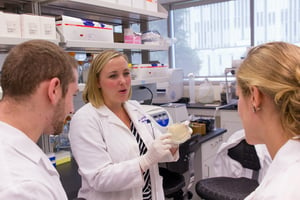
G-Biosciences and Ellyn Daugherty have compiled a simple list of equipment and materials required for a new biotechnology teaching lab. When setting up a new lab, it is often quite daunting, as it is hard to budget and plan if you are unsure of the basic requirements for the lab. This blog is designed to highlight the key requirements for a lab to accommodate 8 lab groups.
Safety
The first step is to consider safety. For safety, you will need 32 pairs of safety goggles and 16 boxes of gloves. Make sure to get a range of sizes and non-latex options for those with a sensitivity to latex.
Benchtop Equipment
A biotech lab without benchtop equipment is just a classroom, but what and how much equipment do you actually need to run a biotech course smoothly?
- Two microcentrifuges to spin small (0.5-2ml) centrifuge tubes.
- A larger format centrifuge for 15ml centrifuge tubes.
- Electronic balances to weigh reagents down to 0.0001g (2) and 0.001g (4).
- Two heat blocks/dry water bath for 1.5ml tubes, used to incubate and heat samples.
- Eight horizontal electrophoresis gel boxes (6-10 wells) for running DNA samples.
- Eight sets of three micropipettes for measuring small volumes of liquid.
- P100 or P200 for 10-100µl or 20-200µl respectively.
- P1000 for 100-1,000µl.
- P20 for 2-20µl.
- 32 micro centrifuge tube racks.
- 4 power supplies for use with the gel boxes.
- 2 spectrophotometers to measure colorimetric assays and other measurements.
- 4 stirring hot plates for mixing and heating solutions.
- A UV transilluminator or the safer alternative, a blue light LED transilluminator, to view DNA in agarose gels.
Four protein electrophoresis gel boxes for separation of proteins. These are often coupled with wet Western transfer units for Western blotting.
Adapted with permission from Ellyn Daugherty






